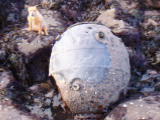Motor Launch H.M.M.L.403
At
Runswick Bay
22nd
August 1918
Built by ELCO The
Electric Launch Company of New
Jersey these 86 foot long wooden
hulled motor launches were used
by the British Navy during World
War 1 as submarine chasers and
mine sweepers. The launches were
armed with a threepounder gun on
the foredeck, depth charges on
the aft and driven by a petrol
engine at up to 19 knots. Usually
crewed by eight R.N.V.R. the
boats were nicknamed "Movies"
due to their motion in the water.
After
the war most of the M.L.’s
were sold off very cheaply many
being converted into pleasure
craft.
M.L.403 was one of several
launches operating along the East
Coast and a regular visitor to
Whitby Harbour. On the 21st
August 1918 a German submarine
fired a torpedo at a northbound
steamer off Runswick Bay. The
steamer’s lookouts watched
the torpedo’s wake as it
passed them and ran onto rocks in
the western side of the bay
without exploding. Signals were
sent to motor launches anchored
in the bay and the submarine was
pursued and depth charged.
On
the 22nd it was
decided to recover the torpedo
and Lieut. A. Whiting R.N.V.R.
was tasked with the dangerous
procedure. It was a perfect
summer’s day as M.L. 403
left Whitby and travelled to
Runswick Bay. She was accompanied
by a second launch and manned
with a crew of ten plus two
torpedo experts. The torpedo was
soon located about a two hundred
meters from the cliffs. People
gathered on the cliff top to
watch as the torpedo was safely
lifted out of the water. Just
after 2o'clock as the experts
began to remove the warhead there
was a large flash, the torpedo
had detonated. This was followed
quickly by another as the four
depth charges on the afterdeck
went off in sympathy and then a
third explosion as the vessel’s
petrol began to burn. The shock
from the explosion broke many
windows brought down ceilings and
damaged roofs in Runswick village.
It was heard as far away as
Scarborough. When the shocked
spectators had picked themselves
up and the smoke form burning
fuel cleared they saw all that
was remaining of the launch was
the bow section which had been
blown close into the shore. Of
the ten crew and two experts only
the Coxswain survived. He had
been feeling unwell for several
days and was laid down in the
forecastle at the time of the
explosion. He was quickly taken
to Middlesborough hospital where
he remained for several weeks.
"Lieut.
Whiting had earned much
popularity during his stays in
Whitby, and his demise was deeply
regretted as was that of his crew"
Whitby Gazette
| 